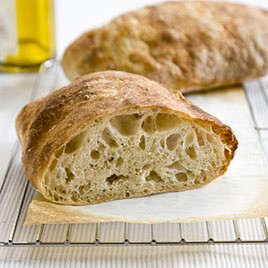Ciabatta

Two tablespoons of nonfat milk powder can be used in place of the liquid milk; increase the amount of water in the dough to 1 cup. As you make this bread, keep in mind that the dough is wet and very sticky. The key to manipulating it is working quickly and gently; rough handling will result in flat, tough loaves. When possible, use a large rubber spatula or bowl scraper to move the dough. If you have to use your hands, make sure they are well floured. Because the dough is so sticky, it must be prepared in a stand mixer. If you don’t have a baking stone, bake the bread on an overturned and preheated rimmed baking sheet set on the lowest oven rack. The bread will keep for up to 2 days, well wrapped and stored at room temperature. To recrisp the crust, place the unwrapped bread in a 450-degree oven for 6 to 8 minutes. The bread will keep frozen for several months wrapped in foil and placed in a large zipper-lock bag. Thaw the bread at room temperature and recrisp using the instructions above.
Biga
1 cup unbleached all-purpose flour (5 ounces)
1/8 teaspoon instant or rapid-rise yeast
1/2 cup water (4 ounces), at room temperature
Dough
2 cups unbleached all-purpose flour (10 ounces)
1/2 teaspoon instant or rapid-rise yeast
1 1/2 teaspoons table salt
3/4 cup water (6 ounces), at room temperature
1/4 cup milk (2 ounces), at room temperature (see note)
1. FOR THE BIGA: Combine flour, yeast, and water in medium bowl and stir with wooden spoon until uniform mass forms, about 1 minute. Cover bowl tightly with plastic wrap and let stand at room temperature (about 70 degrees) overnight (at least 8 hours and up to 24 hours).
2. FOR THE DOUGH: Place biga and dough ingredients in bowl of stand mixer fitted with paddle attachment. Mix on lowest speed until roughly combined and shaggy dough forms, about 1 minute; scrape down sides of bowl as necessary. Continue mixing on medium-low speed until dough becomes uniform mass that collects on paddle and pulls away from sides of bowl, 4 to 6 minutes. Change to dough hook and knead bread on medium speed until smooth and shiny (dough will be very sticky), about 10 minutes. Transfer dough to large bowl and cover tightly with plastic wrap. Let dough rise at room temperature until doubled in volume, about 1 hour.
3. Spray rubber spatula or bowl scraper with nonstick cooking spray; fold partially risen dough over itself by gently lifting and folding edge of dough toward middle. Turn bowl 90 degrees; fold again. Turn bowl and fold dough six more times (total of eight turns). Cover with plastic wrap and let rise for 30 minutes. Repeat folding, replace plastic wrap, and let rise until doubled in volume, about 30 minutes longer. Meanwhile, adjust oven rack to lower-middle position, place baking stone on rack, and heat oven to 450 degrees at least 30 minutes before baking.
4. Cut two 12- by 6-inch pieces of parchment paper and liberally dust with flour. Transfer dough to liberally floured counter, being careful not to deflate completely. Following photos 6 through 9 above, liberally flour top of dough and divide in half. Turn 1 piece of dough so cut side is facing up and dust with flour. With well-floured hands, press dough into rough 12- by 6-inch shape. Fold shorter sides of dough toward center, overlapping them like business letter to form 7- by 4-inch loaf. Repeat with second dough piece. Gently transfer each loaf seam-side down to parchment sheets, dust with flour, and cover with plastic wrap. Let loaves sit at room temperature for 30 minutes (surfaces of loaves will develop small bubbles).
5. Slide parchment with loaves onto inverted, rimmed baking sheet or pizza peel. Using floured fingertips, evenly poke entire surface of each loaf to form 10- by 6-inch rectangle; spray loaves lightly with water. Carefully slide parchment with loaves onto baking stone using jerking motion. Bake, spraying loaves with water twice more during first 5 minutes of baking time, until crust is deep golden brown and instant-read thermometer inserted into centers of loaves registers 210 degrees, 22 to 27 minutes. Transfer to wire rack, discard parchment, and cool loaves to room temperature, about 1 hour, before slicing and serving.
RECIPE TESTING
Ridding Bread of Oversized Air Holes
While developing our recipe for ciabatta, we kept encountering a vexing problem: loaves pitted with air holes so big, there was hardly any bread. Would adding a small amount of milk—a technique often used by commercial bakers—fix the problem?
EXPERIMENT
We replaced ¼ cup of water in the ciabatta dough with an equal amount of milk and compared the baked loaf to one prepared without milk.
RESULTS
The ciabatta with milk sported air pockets decidedly smaller than those in the no-milk loaf.
EXPLANATION
Milk contains a protein fragment called glutathione that slightly weakens gluten, the network of proteins that give bread its structure and chew. When the bonds in gluten weaken, more steam is able to escape from the dough, leading to smaller bubbles.
None Available.